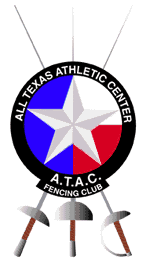Introduction to Fencing
Introduction to Fencing
The Weapons
|
||||
Foil
|
 |
|||
The foil is approximately 35 inches in length and weighs less than one pound (16 ounces). Points are scored with the tip of the blade and must land within the torso of the body. The valid target area in foil is from the shoulders to the groin, front and back. The target area does not include the head, neck, arms and legs. Fencers wear a metallic vest called a lame, which covers the valid target area so that a valid touch will register on a scoring machine when fencing in competitions.
|
||||
Epee
|
 |
|||
The epee is the descendent of the dueling sword. It weighs approximately 27 ounces, has a larger bell guard to protect the hand and a stiffer blade than the foil. Touches are scored only with the point of the blade; however, the entire body is the target area.
|
||||
Saber
|
 |
|||
The saber is the modern version of the slashing cavalry sword and is similar in length and weight to the foil. The saber is a thrusting weapon as well as a cutting weapon; therefore, the tip and the entire blade are used. The target area is from the bend of the hips to the top of the head, front and back, simulating the cavalry rider on a horse. The saber fencer's uniform includes a metallic jacket called a lame, which covers the valid target area so that a valid touch will register on a scoring machine when fencing in competitions.
|
||||
Choosing a Weapon
Students at the ATAC Fencing Club are initially introduced to the epee. The epee skills are easier to comprehend for the beginning fencer. At times, a foil or saber student will be asked to return to the basics of epee to retrain certain skills. We recommend beginner fencers learn epee for at least the first 4-6 months of fencing. All beginner fencers will fence with "dry," or non-electric, weapons. As students progress, the coach may recommend advancing to electric equipment. All competitive fencers are required to meet the current requirements of the USFA rules and ensure their equipment is in good working order. Instructors in the Intermediate and Advanced Epee classes may introduce students to the foil or saber. Students usually develop an interest in, or preference for, a specific weapon and request classes or lessons for that weapon.
How to Follow the Action
(excerpted from the 1998-99 U.S. Fencing Fact Book)
Focus on one fencer. The fencer being attacked defends himself by use of a "parry," a motion used to deflect the opponent's blade. Whenever a hit is made, the director will stop the bout, describe the actions, and decide whether to award a touch. Fencers seek to maintain a safe distance from each other, then one will try to break this distance to gain the advantage for an attack.
|
||||
Fencing "Electric"
|
 |
|||
(excerpted from the 1998-99 U.S. Fencing Fact Book)
Red/Green lights mean a point or blade has landed in a valid target area. A point is scored for the fencer who makes the hit, depending
|
||||
on the referee's decision of right-of-way. White light in foil means the point has landed outside of the valid target area. No point is awarded for an off-target hit. One or more lights requires the referee to determine which fencer had right-of-way in foil and saber. In epee, a point is awarded to both fencers.
|
||||
What Do the Terms Mean?
(excerpted from the 1998-99 U.S. Fencing Fact Book)
Advance: Step forward with a fencer's front leg
Attack: Movement or series of movements by which a fencer tries to score a point against his opponent.
Beat: Sharp tap on the opponent's blade to initiate attack or threat of attack.
Counter(or
Circular)-parry: a defensive movement by which the fencer
makes a small circle with the tip of the blade, around the
opponent's blade and moves the opponent's blade away.
Disengage: Break of contact between fencers' blades; movement made by passing the blade under the opponent's blade.
Engagement: Contact of blades.
En garde: Position taken before a bout begins.
Feint: A false attack intended to get a reaction from the opposing fencer which will open them up to a genuine attack.
Fleche: A running attack.
Lunge: Most common attack in which the fencer closes the distance by moving the front leg forward while the back leg remains stationary and straightens out.
Parry: Defensive action in which a fencer blocks his opponent's blade.
Recover: Return to the en garde position after lunging.
Remise: Attacking again immediately after the opponent's parry of an initial attack.
Riposte: Defender's
attack after parrying an attack.
|
||||
